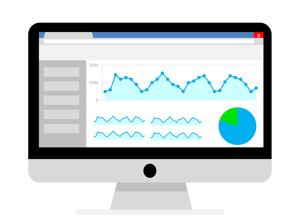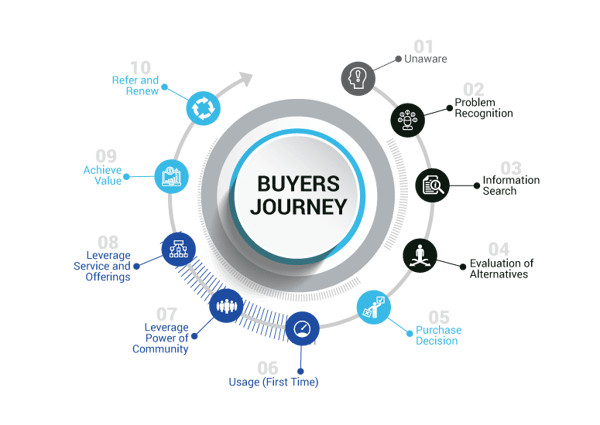

Have you ever faced the rough realization that a majority of your digital marketing isn't strategically data-driven? As a proud, self-proclaimed 'data-driven' marketer, this was a tough pill for me to swallow.
To be clear, it wasn't that I wasn't using data and industry best practices to influence my digital marketing strategy; I was. However, the level of data analysis was very tactical and I often arrived at conclusions that a data expert may find laughable due to the insignificance of the data supporting them. Even when I achieved great results it often felt more like dumb luck rather than the validation of well-drawn hypotheses.
If you've ever experienced this or similar feelings, this article is for you. In it, I will outline practical steps you can take that will empower you to analyze data on a more strategic level so you can hopefully do a little less 'shooting from the hip' (even if you've gotten quite good at it.)
The Difference Between Reporting & Analysis
First, it is important to distinguish between reporting and analysis as we will be talking about them both. While not completely isolated from each other (hence us talking about both), they are unique.
Reporting is a demonstration of results. We report to relevant stakeholders about the failures and success of our campaigns. Every stakeholder is looking to see something different, a marketing manager may be interested in more tactical metrics while a C-suite exec is likely looking for bottom-line results.
Analysis, on the other hand, is the interpretation of data. We analyze to inform decision-making at both the tactical and strategic levels. Now that you have a clear understanding of the main distinctions of reporting and analysis, let's clearly define the problems that impede strategic-level data analysis.
Common Mistakes Digital Marketers Make with Data Analysis

Every marketer knows that proper data analysis is critical to the long-term success of any organization. And shortcomings of data analysis don't derive from a lack of effort, but rather mistakes in the approach. Let's discuss 6 of the most common mistakes digital marketers make in data analysis to guide our analysis restructuring.
1. Spending Too Little Time On Analysis
Marketing is a lot of work. And when we get busy, we tend to prioritize execution over analysis. Why do we do this when we know the importance of thorough analysis? Hard to say. And also isn't. Without getting shit done, there isn't really anything to analyze. Plus, analysis can often feel daunting. Especially if, after hours of analysis, you come up with nothing useful. Which brings us to our next point.
2. Spending Too Much Time Combing Through Data
This is what I struggled with most and is also the inspiration for the framework I lay out in the next section. I've spent more time than I'd like to admit trying to find the data story, something that was strategic, valuable, and compelling, something an entire campaign could be developed around. So if you find yourself getting lost in the data, this post is for you.
3. Improperly Attributing Significance To Data
To preface this section: we are marketers, not data scientists. Still, we need to hold ourselves to a higher standard of ensuring the insights we draw are significant because these insights inform our decision making. Whether we are developing a campaign, making a pivot in an existing one, or reallocating budget to different channels, we rely on the insight drawn from data.
Just to be clear, I'm not recommending we perform significance testing on all data. Most of us don't have those capabilities, as even large, established organization struggle with it. I'm simply suggesting, we don't jump to conclusions, because it is convenient. We need to identify probable causes of events and develop tactical tests to further narrow down the list of possibilities until we arrive at a reasonable conclusion. Proper analysis requires consistent testing and validation of conclusions.
4. Mistaking Tactical Analysis For Strategic
 In my humble opinion, this is where a majority of non-technical marketers struggle. We are constantly asked to report results and insights on progress, when in reality we may have not found any significant insights. In these situations, it is easy to report on tactical level items, because we feel we need something to report.
In my humble opinion, this is where a majority of non-technical marketers struggle. We are constantly asked to report results and insights on progress, when in reality we may have not found any significant insights. In these situations, it is easy to report on tactical level items, because we feel we need something to report.
There is nothing wrong with tactical analysis. However, using the tactical insights for strategic-level decision making causes issues. We shouldn't develop an email campaign based on open rates. We use open rates to optimize ongoing email campaigns by testing send times, subject lines, preview text, etc.
If you need a guide for which metrics empower strategic-level action and which enable tactical-level action, check out the impact matrix developed by Avinash Kaushik. The matrix is a useful structure for mapping out your own KPIs.
5. Focusing On The Wrong Metrics
Even with strategic metrics in place, they may be the wrong metrics for your organization. It can be easy to replicate the metrics other organizations are using. However, these metrics may not be aligned with your goals or even your organization. Don't fall into the imitation trap; use that creative brain to identify what is critical to your organization and start there.
6. Not Providing Appropriate Context For Reports
Reporting is critical to receiving buy-in for strategy and informing higher-level decision-makers about successes and failures. These decision-makers love to make decisions. Surprise surprise. However, without the appropriate context of these "results", their decisions may be drastically misinformed. A thorough analysis of underlying causes is critical to providing the appropriate context for the results being reported.
This problem occurs most frequently (opinion) with automated reports. Automating reports can be incredibly useful, but if key decision-makers see these reports and make decisions without the context discussed above, campaigns will be derailed and your marketing efforts will suffer.
Marketing takes time and you will undoubtedly come across vital stakeholders who don't understand that. These individuals will be quick to change directions and shift strategy, which can be great in certain situations, but catastrophic in others (typically those with little context.) As the marketer, you 're responsible for identifying the underlying causes of the results and you're responsible for defending the strategy if it is too early to pivot. Know the data you share.
A Simple & Adaptable Framework
The framework discussed in this section is in no way a panacea. Attribution, reporting, and analysis are huge ever-evolving challenges. My hope is that this framework acts as a launchpad for anyone intimidated by any of these beasts.
0. Personas & Buyer's Journey
Always start with the customer. They are the foundation for any effective marketing strategy and should always be the center of focus for everything you do.

Ensure you've clearly defined each persona, plotted their buyer's journey, and mapped out what resources you have for each of these stages.
1. Clearly Define Your Goals
No surprises here. The first question before you begin analysis with is 'What am I trying to achieve?'. I'm not going to dive deep into goal setting here, but here is a great resource if you need some help. Once these goals are developed, you can work backward to identify key objectives and the tactics needed to achieve these objectives and goals as well as the KPIs you'll be measuring for each (more on that in a second.)
With clearly defined goals and measurements, you will develop a greater understanding of what data you need to track and clean (more on that in a couple of seconds).
2. Identify KPIs & Strategic Metrics
The next step is to identify which KPIs you will need to determine if your digital marketing is successful. It is also the step where you establish which Strategic Metrics will provide you with valuable insight into the health of your campaign (as opposed to just the results.) Remember, these should be aligned with your marketing goals.
There is a subtle, but critical distinction between how I choose to use KPIs and Strategic Metrics. KPIs enable us to evaluate the overall progress of a campaign and, once completed, determine if it is a success or failure. Strategic Metrics, on the other hand, I view as diagnostics, which keep a pulse on key areas of the campaign. If something is going wrong (or right) we can quickly identify the area and analyze it to generate strategic-level insights.
Examples of KPIs include: marketing qualified leads (MQLs) generated from social media, leads developed from pay-per-click campaigns. Examples of Strategic Metrics include customer lifetime value (CLV), voice of customer (VoC), and customer acquisition cost (CAC).
Depending on how your organization is run, you may treat these the same, but there are instances where they are not, and where you will keep the key metrics for internal analysis and report the KPIs to the relevant stakeholders. Especially in the latter case, ensure your KPIs also take the interests and goals of the relevant stakeholders in mind.
Note: When identifying the Strategic Metrics, be selective. Trying to create too many right away may result in you losing steam during your analysis initiatives. Additionally, it could result in you identifying a bunch of tactical metrics that will bog you down as you try to develop strategic-level insights.
If you are still struggling to distinguish between strategic level metrics and tactical and the impact matrix I linked earlier isn't helping, here is a resource.
Together, properly defined KPIs and high-level metrics reduce the amount of time spent combing through data, ensure you are focusing on only the important areas, and enable you to draw strategic-level insights.
3. Map & Prioritize Attribution Requirements
 Now that you've identified which KPIs and Strategic Metrics you want to develop, you need to map out the data attribution requirements. I'll be the first to admit attribution is a monster. Many organizations find it too intimidating to tackle, but if you start small and accept the reality that your V1 isn't going to compare to your dreams, you'll be okay.
Now that you've identified which KPIs and Strategic Metrics you want to develop, you need to map out the data attribution requirements. I'll be the first to admit attribution is a monster. Many organizations find it too intimidating to tackle, but if you start small and accept the reality that your V1 isn't going to compare to your dreams, you'll be okay.
Steps of Mapping Attribution:
- Determine which attribution method is right for you
- Use the KPIs and Strategic Metrics you identified in the previous step
- Identify which sources need to be tagged and how
- Determine the areas, if any, that are unfeasible and prioritize any necessary tradeoffs
- Brainstorm ways to mitigate the effects of unattributable data
- Map out an implementation plan
- How are you going to track each of these data sources? How are we going to build the KPIs & Strategic Metrics?
- Who needs to be involved?
- How can we mitigate uncertainty for those involved and ensure accuracy?
- Do we need to aggregate the data from multiple sources?
4. Implement Attribution & Build Metrics
The planning stages of the process have been completed and now it is time to put the gloves on (so to speak) and get to work. Unfortunately, I can't help you as much as I'd like during this stage. It is too unique to your organization.
On a high-level, you will be using your implementation plan to:
- Develop the tracking mechanisms that will properly attribute the necessary data
- Aggregate the tracked data where needed (if needed)
- Build the KPIs and Strategic Metrics using the attributed and aggregated data
Although I can't help with the implementation, I do have some advice from my experiences with the matter. Stay calm, flexible, and persistent. Understand even large, established organization struggle with this stuff and it is an ongoing process that requires a lot of learning. Take strong notes about your approach, the wins and losses and lessons learned, and jot down any ideas on how you can do better the next go-around; I guarantee there will be another go around and that is a good thing!
5. Use & Review
The final stage of the framework is use and review. Use the KPIs to inform you about the progress and end results of your campaign(s) and use your Strategic Metrics as starting points for your high-level analysis. Afterward, review what has improved and what still needs to be improved. If there are any opportunities for quick wins and fixes, implement them. Otherwise, taking the lessons learned, work through the process again.
I hope you found this framework for leveling up your digital marketing reporting and analysis helpful because leveling up in this area has never been more critical for marketers and their businesses than it is now. This trend isn't going anywhere. The competition will get fiercer, clients and executives will expect more, and the amount of data is going to be overwhelming. By starting now, you're putting yourself in a better position to outmaneuver competitions, wow your clients and executives, and process the data more efficiently and effectively. I wish you nothing but the best in your endeavors.
If you enjoyed this blog, follow me on LinkedIn, I plan to do more in-depth pieces on data analysis. Stay tuned! Also, subscribe to the Cutting Edge for more great content from my amazingly knowledgeable coworkers.
